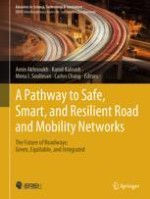This book provides case studies and state-of-the-art research findings for cutting-edge technologies relevant to transportation infrastructure projects, with emphasis on safe, smart, and resilient road and mobility networks. The market share of the global infrastructure projects is estimated at $3.4 trillion, the socioeconomic rate of return is around 20%, and significant progress has been made in the last decade in maintenance of existing projects and to improve future construction projects for the well-being of the society. Different book chapters focus on emerging challenges including readying road infrastructure to autonomous vehicles, safety of road users, increased efficiency and sustainability of infrastructure projects, and advances in construction materials and technologies of highways, tunnels, and bridges. State-of-the-art research includes the current and future applications of unmanned aerial vehicles (UAV), intelligent transportation systems (ITS), artificial intelligence (AI), Internet of things (IoT), big data, smart materials, and additive manufacturing (AM). This book is intended for transportation professionals, policy makers, researchers, practicing engineers, researchers, graduate students, and public and private sector transportation personnel
